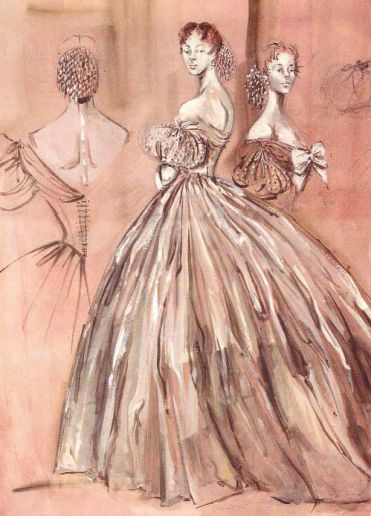
I had a lot of pleasure when I wrote about Cecil Beaton’s costumes for My Fair Lady for The 31 Days of Oscars Blogathons (the crafts). So, when Christina Wenher and Into the Writer Lea announced their Characters in Costume Blogfest, I thought it was a most appealing idea. I obviously wanted to talk about a movie where the costumes were one of the major elements. Was I to go with something extravagant like Watler Plunkett’s costumes for Gone With the Wind or something more sober, but always refine, like Adrian’s costumes for The Philadelphia Story. Well, I opted for the first option and Irene Sharaff’s costumes for The King and I was my chosen subject. Today, I will only focus on this aspect of the film. Of course, I thought it was a great film. Yes, Deborah Kerr and Yul Brynner are marvellous in it, but that’s not what I want to talk about in details.
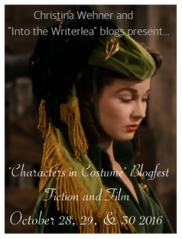
I warn you, this post might contain some spoilers as I will relate the evolution of the costumes to the evolution of the story. So, be careful if you haven’t seen the film yet!
***
The King and I is a musical directed by Walter Lang and released in 1956. It stars Deborah Kerr, Yul Brynner, Rita Moreno, Terry Saunders and Martin Benson. It was an adaptation of the Broadway musical of the same name by Oscar Hammerstein II and Richard Rodgers, itself based on the novel Anna and the King of Siam by Margaret Landon, Ernest Lehman wrote the script. The King and I was a winner of five Oscars: Best Actor in a leading role (Yul Brynner), Best Art Direction- Set Decoration, colour (John DeCuir, Lyle R. Wheeler, Walter M. Scott, Paul S. Fox), Best Costume Design, Color (Irene Sharaff), Best Music, Scoring of a Musical Picture ( Alfred Newman and Ken Darby) and Best Sound Recording (Carlton W. Faulkner). It was also nominated for Best Picture ( Charles Brackett), Best Actress in a Leading Role (Deborah Kerr), Best Director (Walter Lang) and Best Cinematography, Color (Leon Shamroy).
The King and I certainly was a financial success, and also a critical one. However, it was criticized for some changes in the original dialogues and the omission of some songs. The film was banned in Thailand due to its inaccurate representation of King Mongkut of Siam. But overall, The King and I was a movie made to be remembered!
The story takes place in Siam (actual Thailand) and starts in 1862. Anna Leonowens (Kerr), a young English widow, has come to Bangkok with her son Louis (Rex Thompson) to be the teacher and governess of King Mongkut (Yul Brynner)’s numerous, but most adorable children. She is forced to live in the palace due to the unkept promise of the king to provide her a house. Anna will be here not only to help the children, but also the king himself (even if he’ll never admit he needs help) and the king’s sad last wife, Tuptim (Rita Moreno), who is unhappy and misses her lover terribly.
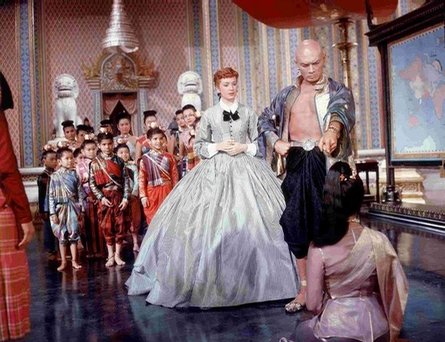
It’s hard to resume The King and I because it’s not really a story, but more a situation. Anyway, I hope this had gives you a good preview of it.
***
But let’s move to our main subject: the costumes.
Irene Sharaff certainly deserved her Oscar for her brilliant creations. Of course, both the European fashion of the 19th century and the Siamese traditional fashion are used in this film. Deborah Kerr is always seen with those big, but oh! so elegant crinoline dresses. Apparently, Deborah Kerr’s gowns each weighted between 30 and 40 pounds due to the pleats, hoops, and petticoats (IMDB). And to imagine now that girls are sometimes practically naked in the street… Of course, I think each type of fashion had its advantages and disadvantages.
Interestingly enough, Irene Sharaff worked both on the stage and film costumes of The King and I.

Irene Sharaff’s costumes for The King and I are some that seem to have been perfectly calculated in function of the story and in function of the sets. We, indeed, can often observe how a certain fabric matches perfectly the colour of the walls or the furniture. That’s what makes this film visually stunning. If Sharaff’s costumes are very colourful, there’s nothing too extravagant about them, precisely because they blend into the scenery.
***
It’s interesting, however, to talk about these costumes in the same order as the story:
At the beginning of the film, Anna arrives on both with her son. They both wear blue. A big light blue crinoline dress for Anna and a little light blue ensemble for Louis. These are chic, but still sober costumes. Well, today it’s not exactly with THIS type of dress we’ll be travelling, but remember, we are back in 1862. There’s not much said about Anna’s past (except for her dead husband), but this type of dress gives us the clue that she comes from the high society (and also the fact that she’s going to be the governess of a king’s children). We can see little white flowers embroidered around the dress’s buttons. Her belt is an accessory that emphasizes her tiny waist. It is small details like that that makes all the difference. We can also observe white gloves on Anna’s hands. Her dress is not a very revealing one and the sleeves are long. Is it more practical for travelling on a boat where the wind can be quite violent?
Light blue and white are two colours that always are beautiful together, like the sky and its clouds. Blue is a colour that will often be associated with Anna. She often wears light blue gowns in the film. Is it a way to reflect her personality? Apparently, blue is a symbol of wisdom, calm and liberty. Anna certainly is a wise person. Calm? Hum, maybe not the calmest person. She is working for the king, but it is obvious she wants to keep her liberty. To live out of the palace is a first clue for this seek of liberty and, remember she is not the king’s servant! 😉
When Anna meets Kralahome and his servants on the boat, we can observe how those are dressed, with baggy pants and are topless. Unlike Anna, they wear a lot of golden jewels and gems. They also have those very distinguished triangular coifs.
When Anna is brought to the palace, we can observe how the image is very clear and light. It goes well with the characters’ clothes. We can also notice that blue and golden are two omnipresent colours, especially in the king’s palace.
When Anna first meets the king, this one wears black. On his shirt, we can observe some little silver rounds. Black is a colour that has often been associated with authority. It is a colour we can associate with feelings of sadness, fear and wickedness. It’s hard to seize the king, and what kind of man he is. So, can we associate this colour to his personality? I think, here, black has a role of domination. It’s an imposing colour and that’s what the king wishes to be.

When Anna arrives at the palace, she also sees Tuptim (Moreno) for the first time. She is brought to the king as a gift and to become one of his several wives. In this first appearance, Tuptim wears a very elegant beige gown with a multitude of white pearls on it. Unlike Anna’s dress, this one is much more, “thin” and follow her body line.
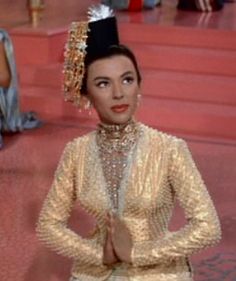
The king’s wives all wear very colourful costumes made of what seems to be silk. Obviously, Siam is a country with a hot weather, explaining why the men are often topless and women’s gowns are made of lightweight fabric. When Anna first meets the wives, we can notice that their clothes are more of light than dark colours. The little kids wear those cute little “hats” that look like buns and long coats decorated with embroideries.

During Anna’s first night at the palace. There’s this funny scene where the king’s wives look at Anna’s dresses in her suitcase. They think those BIG dresses are quite funny. That’s when two completely different cultures meet.
***
In his next appearance, the king wears dark green, a softer colour than black. It is a colour that matches perfectly his big green ring. The children wear clothes with motifs and they are ready for Anna’s lesson. This one always wears a crinoline dress. The dress is white with blue-green lines on it. There is a little white collar on it and we can notice the black buttons and ribbons. Her son Louis wears a suit that is very similar to the first one, but, this time, it is brown.

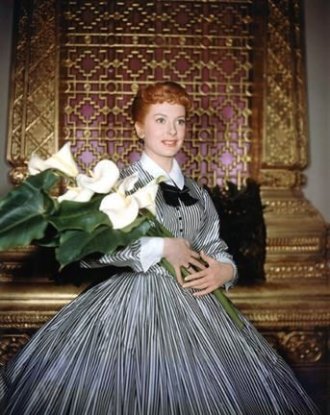
During this class scene, it’s funny how we can see how Anna and the children’s clothes look like the world map Anna has brought. Indeed, the children with their very colourful clothes are like the many countries, and Anna, with her big blue dress, is like the ocean. There’s also this humorous moment when Anna dances with a Siamese lady. As the Siamese lady doesn’t wear a big dress like Anna, the children go around her to imitate the shape of a crinoline dress! We can notice, in this scene, the use of red fans.
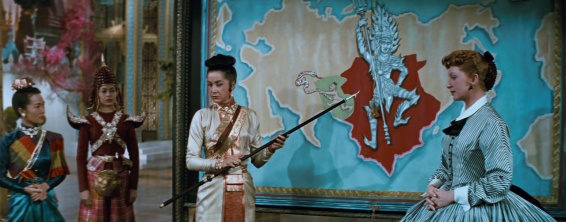
***
For her third appearance, Anna first wears a white nightgown. Coquette, but not as large as her day gowns. Otherwise, it wouldn’t be very practical to lay in bed! The king wants to see her (yes, at the middle of the night) so, after having put a blue shawl, she changes her nightgown for more suitable clothes for a meeting with the king. This time, she doesn’t wear a blue dress, but a white one, with lace and a black waist. It is not the type of clothes we’ll have the tendency to wear these days during a night meeting! Because, obviously, we all have meetings with a king in the middle of the night. What? Don’t you? Oh, that’s a shame… 😉
Anyway, during this precise nocturnal meeting. The king wears something that looks a lot like a red pajamas with silver embroideries on it. To be honest, I wasn’t really sure if it was a pyjamas or just some ample clothes… It is the middle of the night, so it’s quite confusing. Red is a colour that is associated with energy, dynamism, and passion and this scene is a proof that the king has all of them! The king’s ample clothes allow him to move easily and with a certain suppleness.

Later during the night, Tuptim’s lover, Lun Tha (Carlos Rivas) comes to the palace to meet her. Thanks to Anna, they can have a secret meeting in the palace gardens. Visually, and thanks to the costumes, this scene is stunning. Tuptim wears a very delicate and light silk gown that makes her look like a fairy. Both Tuptim and Lun Tha wear clothes in the tons of green and blue: An oriental dress for Tuptim and long baggy pants for Lun Tha. We can notice that the Siamese women wear a lot of veil on their clothes. Tuptim doesn’t make an exception in this scene. The colours of Tuptim and Lun Tha’s clothes fit beautifully with the nature around them, the plants, and the water in the king’s gardens, and to the night itself. That’s why it’s such a memorable visual moment.

***
For his fourth appearance, the king wears a blue shirt with long sleeves and check pants. Kralahome is seen with a black shirt and long red-check pants. It is again a school scene for Deborah Kerr and, once again, this one wears a blue dress, always very simple, with black buttons and a white collar. The clothes of the Siamese women are of darker colours and look more autumnal than the ones at the beginning of the film. But well, Thailand (or Siam if you prefer) never really is a cold country.
***
Anna’s next costume is seen in this scene where she wishes to live a first time. She is in her bedroom and wears a dress which is more low-necked than the previous ones, and with short sleeves. The very lightweight fabric is light blue and frilled with white embroideries. anna wears a blue ribbon is her hair and more extravagant earrings than the little black ones that she usually wears. The little green ribbons on her dress were chosen perfectly to match the colour of Deborah Kerr eyes. We notice, at this moment, that Anna’s bedroom too is decorated in the tones of blue. Anna’s dress in this scene kind of looks like a big nightgown because of its composition. To be honest, I’m not sure if it’s a dress or just something that goes under one like a underskirt or something like that. I mean, why does she changes it when she goes see the king not long after?

***
The king is then seen in a suit that is in the same shape as is red “pajamas”, but in the tones of brown and golden. The decor behind him is also in those tones. Anna has changed her dress to meet the king. The one she wears is similar to the previous one, but less “sexy”. We can notice the little white lace shoulder pads and the numerous embroideries in the shape of flowers on it. Anna, the king, the children and the wives are then taken to the statue of Buddha. We can see Buddhist monks wearing orange tunics. In Buddhism, orange has always been an important colour as it was known as the colour Siddhartha Gautama (Buddha) wore when he renounced worldly life. It is a crucial scene that will convince Anna to stay.

***
It’s during the ball scene that we’ll see some of the most beautiful costumes. The wives, in this scene, are wearing European dresses, but these ones are very colourful and lack the elegance of Anna’s dresses. They are like a crinoline version of their Siamese gowns. Anna wears a golden dress with pink reflects on it, and baggy sleeves and a big bow on its collar. It certainly is the most elegant, but also the sexiest gown designed by Irene Sharaff for this film. Indeed, unlike most of Deborah Kerr’s previous dress, this one as a large collar that let us see her shoulders. The king notices it, but Anna reassures him that such dresses are quite fashionable in Europe. Anna, of course, wears some accessories to go with the dress, such as elegant long white gloves and a white coif made of pearls in her hair. Deborah Kerr certainly is at the summon of her beauty in this scene.

The European men wear very sober clothes; tuxedos and white shirts, that had nothing to envy to the majestic dress wore by Anna or the flamboyant red ample suit of the king. This one is decorated with golden embroideries, and the king has put a blue banner on his shoulder, which imitates the ones wore by the English gentlemen. He always wears those short baggy pants and this earring that goes so well with the golden details on his red suit. The king also wears a little red hat the same color as his suit. Of course, the European ladies wear crinoline dresses, but unlike Anna’s one, they are more of dark colours. We can notice flowers in the hair of some of them.

To entertain the guest, Tuptim has written her own musical version of Uncle Tom’s Cabin. The little Thai ballet is presented to them and it’s certainly one of the most memorable moments of the film. In the orchestra, women wear pink (a colour so often associated with feminity) and the men wear orange. Tuptim wears a light pink elegant dress and one of those very heavy and complicated coifs that look like a golden chandelier. These “hats” are a distinguished accessory of the traditional Thai dance costume. The dancers are dressed in red and their faces are painted in white, which makes it look as if they were wearing a mask. Eliza, the main character of the play, wears orange. The mean king Simon Legree wears black, a colour that is obviously associated with fear and authority in this film. With the presence of Buddha, dressed in orange, there is a golden light on the stage which creates a calm and soft atmosphere. It’s important to know that, for the Buddhists, orange is a colour they associate to golden. So, one doesn’t go without the other. Orange is both a warm and bright colour, just like golden.
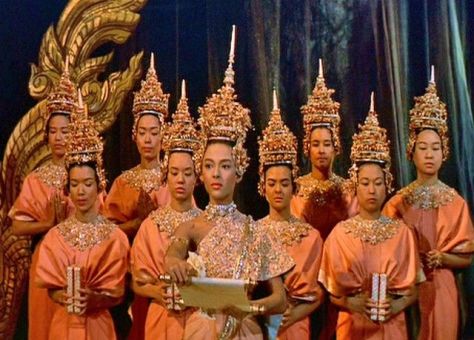
When Anna later dances with the king, we notice how an amazing visual effect her crinoline dress creates when they spin around the room. The king is barefoot, which allows him to move with more ease. It’s hard to say which kind of shoes Anna wears, simply because we never see them. We might barely see them when she’s dancing, but that’s not long enough to jump to conclusions.
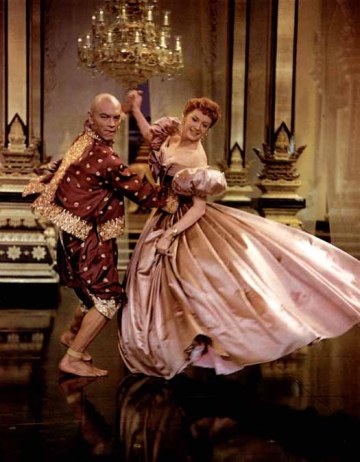
***
Anna’s last gown is a white one, but it still has little blue reflections. We notice the little organic motifs on it and how the fabric seems to be thick. It is a fabric that looks like the one used for her first dress, so we know it’s probably more practical to travel. Because we know, in this scene, that Anna is on her way to go back home. Her son, Louis, still wears a suit that is so similar to the previous one, but it is dark green this time. When the king’s first wife comes to see Anna to tell her that the king is dying, she wears a black gown. We can easily associate this colour with the idea of mourning. The king is on his deathbed, wearing the same brown as his blanket.

***
To create all those costumes, Irene Sharaff used a lot of silk, which created a boom in the Thailand silk industry. We notice the use of orange, red and pink which were her favourite colour. Blue is often present, which was a perfectly chosen colour for Deborah Kerr. Even if most of her dresses are blue, they are all unique, because of a little detail, because of their different shape, because it is not always the same blue.

Irene Sharaff managed to create a real visual masterpiece with her original and distinguished fashion creations. The King and I is a movie we don’t forget and the costumes are one of the major elements that explain that.
Irene Sharaff is also known for having designed the costumes of Gaslight, Meet me in St. Louis, The Best Years of Our Lives, An American in Paris, Guys and Dolls, West Side Story, Cleopatra, Who’s Afraid of Virginia Wolfe and many others. Apart from The King and I, she also won an Oscar for An American in Paris, West Side Story, Cleopatra and Who’s Afraid of Virginia Wolfe. It is not as much as Edith Head, but it’s something to be proud of!
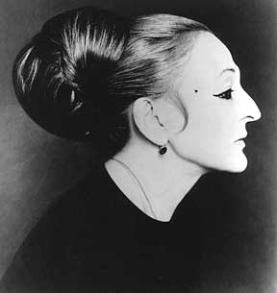
***
Wow, I didn’t think I’ll write 3000 words only about the costumes of a movie… Well, looks like there was a lot to say and this certainly was an entertaining writing process. You most forgive me for the poor quality of some pictures or the lack of them to illustrate some of the described costumes, but I must admit that it was hard to find many good and various pictures for the costumes of this film, despite their importance. Obviously, to watch the film always is the best experience. 😉
A big thanks to Christina Wehner and Into the Writer Lea for hosting this glorious blogfest! You can read the other entries here:
The Characters in Costume Blogfest- Day 1
The Characters in Costume Blogfest – Day 2
The Characters in Costume Blogfest – Day 3
And a happy Halloween to all! 🙂
**Enjoy this blog’s content? Consider supporting The Wonderful World of Cinema HERE!**
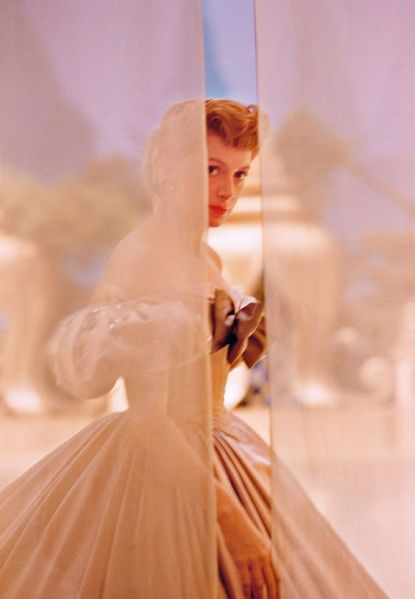
So gorgeous! I’d heard the name of Sharaff, but could not previously tell you which films she had designed the costumes for until reading your post. With a resume such as hers, it’s a shame she’s not better known! I really enjoyed your look at the costumes of this film (and I had not known how the color orange is important in Buddhism). It’s pretty amazing how the costumes in just one movie could cause a boom in silk like that.
In September, I saw The King and I on the big screen and it was so breathtaking. I always wished I could dance in a dress such as hers during “Shall We Dance.” But after reading your post, I want to watch it again.
Thanks so much for joining us!
LikeLiked by 1 person
First time I saw this film it also was on big screen! It certainly is the best way to see it! Thanks so much for your comment. 🙂
LikeLiked by 1 person
Yes, I so agree. It felt like I’d never really seen it properly before. 🙂
LikeLiked by 1 person
[…] The Wonderful World of Cinema talks about Irene Sharaff’s Costumes for The King and I […]
LikeLike
Excellent Virginie! I can’t believe all the detail you noticed and described. Truly amazing!! I had never heard of Irene Sharaff. Your blogs are like takin a film course. 🙂
LikeLiked by 1 person
ahah honestly I didn’t think I’ll have so much to say. Well, looks like I picked a great subject lol. Thanks so much for your kind comment Mike! 🙂
LikeLike
Ahh they just don’t make them like they used to- costumes in movies have really sadly fallen to the back burner- nowadays its just oh this dress, that top with this skirt- no one puts as much work into it anymore- except when dealing with big budget movies, all others don’t seem to matter. These costumes are gorgeous! Haven’t seen this version of the king and I (i saw an animated version when I was like 4?) but I should!
LikeLiked by 1 person
Yes, it’s worthy and not only for the costumes. Deborah Kerr and Yul Brynner are truly glorious as Anna and the king of Siam! 🙂 For today’s movies costumes, I have to say I was quite impressed with Anna Karenina ones and also The Young Victoria.
LikeLike
Wow!! Great post!! I’ve only watched this movie once several years ago but we have it on DVD. If my laptop worked I would take screenshots of the dresses for you 😉
It looks like Anna just added a jacket or something to that low-cut gown as the flowers on the skirt look the same.
LikeLiked by 1 person
Wow! What a fantastic post you have written! I thoroughly enjoyed reading every bit of it.
LikeLiked by 1 person
Wow thank you! I’m glad you enjoyed 🙂
LikeLike
Great post – thoroughly enjoyed reading about all the details of the costumes. Interesting point about them being matched to the sets – something I’d never really thought about, but of course it would be awful if the colours all clashed horribly, especially in a movie like this with such elaborate costumes and set decorations.
LikeLiked by 1 person
Thanks! 🙂
LikeLiked by 1 person
The low-necked dress that she changes out of looks like a corset cover and petticoat, from what I can tell, but now, I definitely have to watch the film again. 🙂 Thank you so much for sharing this great post!!
LikeLiked by 1 person
Thanks to you for your comment! 🙂 Yes that’s what I thought for the white “dress”!
LikeLike
[…] The Wonderful World of Cinema – Irene Sharaff’s Costumes for The King and I […]
LikeLike
I have yet to see this film, but I definitely want to, especially after seeing all of these gorgeous costumes. Wonderfully done post!
LikeLiked by 1 person
Thank you Michaela! I hope you’ll get to see it soon because it’s truly marvellous on every levels 🙂
LikeLike
Bravo! It was a very well-written post!
I think Irene Sharaff was one of the best costume designers in Hollywood, side by side with Edith Head. It’s indeed fantastic how the howns match the scenery (I’m thinking about the Shall We Dance sequence in particular). I also really like Tuptin’s clothes.
Don’t forget to read my contribution to the blogathon! 🙂
Kisses!
LikeLiked by 1 person
I will Leticia! Thanks for the kind comment 🙂
LikeLike
I have been dazzled by the costumes in king and I , since its debut. watching Anna’s dress in the dance is to marvel at silk! balanchine said nothing moves like silk and always dressed his ballerinas in it. bravo to irene sharaf. her costumes rank with breathtaking passion. yul Brenner never looked more magnificent!
LikeLiked by 1 person
[…] 99- Yul Brynner (favourite performance: The King and I) […]
LikeLike